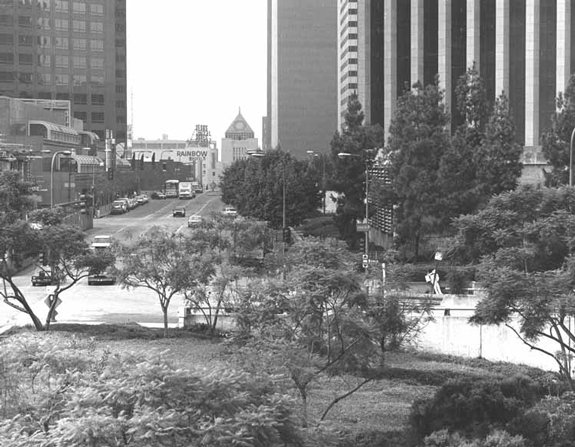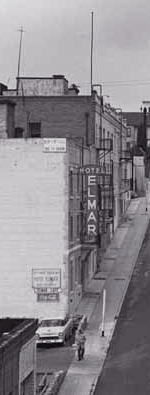
May 22, 1930
William J. Stone, 38, was a Bostonian broker who’d moved to Los Angeles and into the Casa Alta Hotel and Apartments, 317 South Olive. In what may have partly been a case of Don‘t Argue with a Janitor, or partly No-One Likes a Broker in 1930, Stone managed to get into a regrettable debate with the Casa Alta janitor, one Walter Dixon.

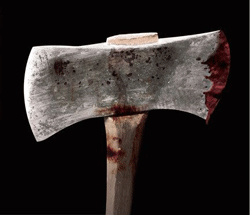
The argument climaxed in Dixon taking a hatchet to Stone‘s head and chasing him from the building. Stone wound up in Georgia Street Receiving Hospital with severe skull lacerations, but lived to broker–or, not–another day, and Dixon landed in the stir on suspicion of ADW.

Here‘s everything you didn‘t know you needed to know about 317 S. Olive, aka The Kellogg, aka the Palace, aka the Casa Alta.
First of all, there are few photos of the place. Pity the poor Palace. It was too large and utilitarian to merit the lens of a Reagh or Hylen. Sure, everybody shot its neighbor, the Ems, and in nearly every Ems image, there‘s the Great Wall of Alta looming in the background:
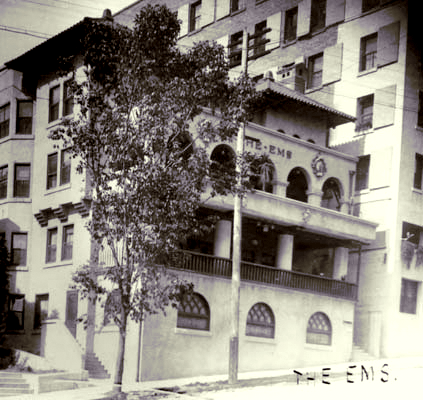
(Don’t look at the Ems. Look at the building behind it. We’ll talk about the Ems next week, I promise.)
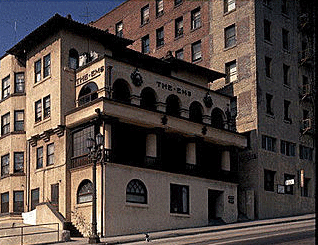
Moreover, whenever one stood on the corner of Third and Olive, the temptation was apparently too great to turn one‘s back on the Kellogg/Palace/Casa Alta and shoot the upper terminal of Angels Flight.
Before the advent of 317, it was 315 S. Olive, which was ground zero for the Burning Bushers.
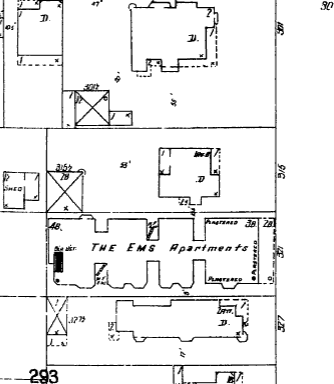
Then came the seven-story, 84-apartment Kellogg. It opens in April, 1908.

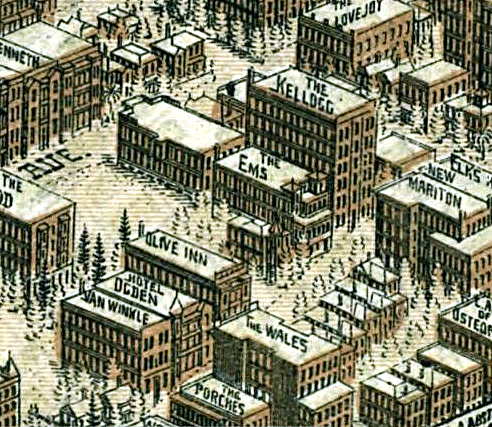
Almost immediately it becomes the Palace Hotel and Apartments; the image at the top of this post, where it’s proudly emblazoned Palace Hotel, is from a card postmarked 1910.
Looking up Olive, ca. 1915: the most prominent, in ascending order, the Auditorium, the Trenton, the Fremont, and at top, the Palace:
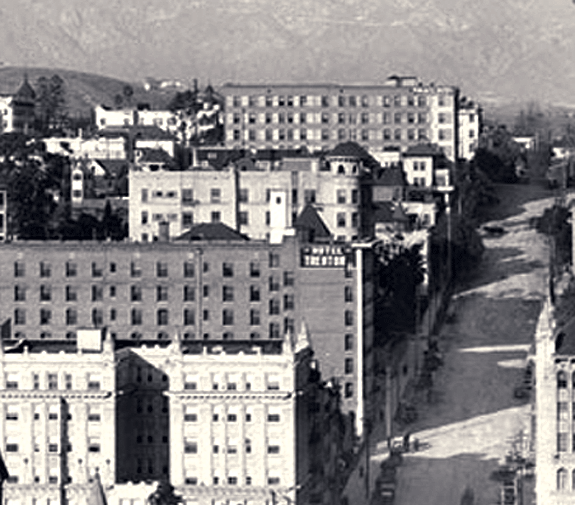
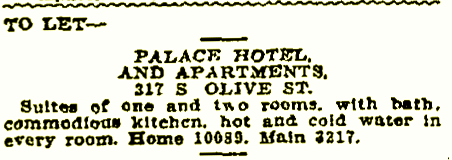
In 1926 the owner puts it out to lease–it is snatched up and becomes the Casa Alta (they have cleverly renamed this rather tall house "tall house," but in Spanish!).

The 1929 City Directory:

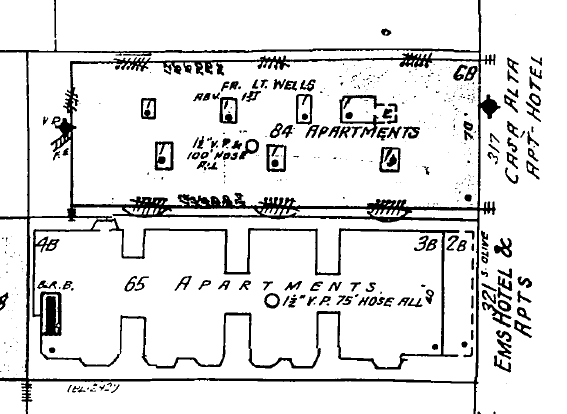
Here‘s what we glean from this 1939 census report: the Casa, faced in brick, has 72 apartments (ok, so the Sanborn Map says 84) in its seven floors, and no business units. There‘s no basement. It was built in 1906, though that doesn’t exactly jive with its April 08 opening date. A nice two-room unit will set you back $27.50 ($406.55 USD 2007), still pretty cheap, but the Hill had begun its downturn even by 1939. Slouching toward shabby though it may have been, nevertheless, that rent was for a furnished apartment, and included heat, water, and electricity.

The 1956 City Directory:
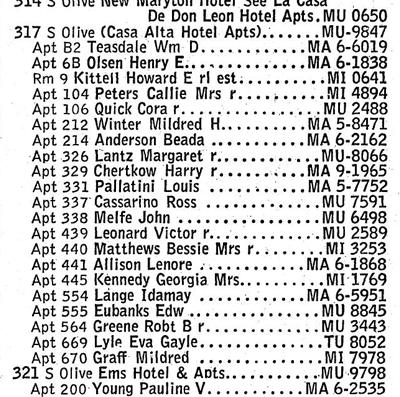
…quite a few folk in the 72 apartments had ”˜phones. Two basement apartments, an office, eighteen tenants had the device. For Bunker Hill, that might have been some sort of record.
By 1965, there were fewer.
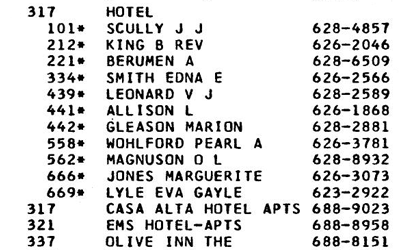
And that’s the last time it appears in the directories.
Here it is as one of the lone survivors, in its final days, ca. 1967. Angels Flight hangs on until 1969.
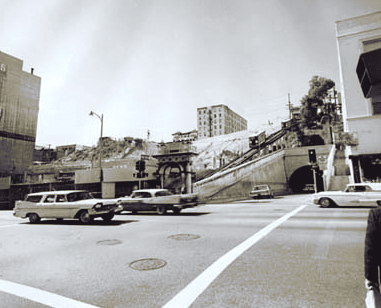
The Palace of Casa Kellogg, and its events of eventful eventfulness:
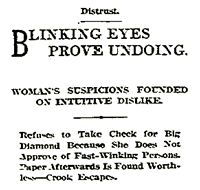 In 1914, the Palace Hotel was where fancy ladies with big diamonds lived. Therefore, of course, sharps and cons knew where to prey. But Lillian Walker was ingrained with common sense and uncommon suspicions. Despite the big car with its monogrammed door, from which stepped the elegantly dressed man and woman who came to her apartment, despite their discourse about rare gems they‘d purchased in the orient, and their winter home in Santa Barbara, Mrs. Walker just doesn‘t trust people who blink rapidly when they talk. The man, who called himself Mullins, eagerly wrote her a fat check for a big diamond, but Mrs. Walker, seeing his blinky eye, said no. She took a $25 check for a small gem, and agreed to meet later to discuss further sales. She immediately verified her suspicions–the checks were false, and Lillian called the authorities–but the grifters got wise to the ambush set for them, and evaded being captured in the Palace.
In 1914, the Palace Hotel was where fancy ladies with big diamonds lived. Therefore, of course, sharps and cons knew where to prey. But Lillian Walker was ingrained with common sense and uncommon suspicions. Despite the big car with its monogrammed door, from which stepped the elegantly dressed man and woman who came to her apartment, despite their discourse about rare gems they‘d purchased in the orient, and their winter home in Santa Barbara, Mrs. Walker just doesn‘t trust people who blink rapidly when they talk. The man, who called himself Mullins, eagerly wrote her a fat check for a big diamond, but Mrs. Walker, seeing his blinky eye, said no. She took a $25 check for a small gem, and agreed to meet later to discuss further sales. She immediately verified her suspicions–the checks were false, and Lillian called the authorities–but the grifters got wise to the ambush set for them, and evaded being captured in the Palace.
 1916 ”“ you may remember the Percy Tugwell case, in which the proprietor of Hotel Clayton (a literal stone‘s throw east at 310 Clay), Florence Cheney, testified. Florence Cheney‘s daughter, Margaret Emery, had her deposition taken at her Palace Hotel sickbed.
1916 ”“ you may remember the Percy Tugwell case, in which the proprietor of Hotel Clayton (a literal stone‘s throw east at 310 Clay), Florence Cheney, testified. Florence Cheney‘s daughter, Margaret Emery, had her deposition taken at her Palace Hotel sickbed.
Margaret testified that Maude Kennedy had been in a fine and jovial mood until very shortly before her death, lending weight to the argument that she committed suicide (Tugwell eventually served ten years in Quentin for manslaughter).
 Christmas Day, 1918, Katherine Lewis quarreled with her husband Lester Lewis. She had been despondent ever since having departed Richmond, VA for Los Angeles; the best course of action, decided Katherine, was to eat bichloride of mercury tablets in their Palace apartment. The physicians at Receiving Hospital fixed her up just enough to try another Christmas.
Christmas Day, 1918, Katherine Lewis quarreled with her husband Lester Lewis. She had been despondent ever since having departed Richmond, VA for Los Angeles; the best course of action, decided Katherine, was to eat bichloride of mercury tablets in their Palace apartment. The physicians at Receiving Hospital fixed her up just enough to try another Christmas.
We‘re all aware that every so often, people sometimes just up and go missing. Dr. Harold E. Roy was a prominent New York dentist whose crushed canoe was found in the Hudson River (it was assumed he was torn asunder by a paddle steamer); his widow moved to Los Angeles and into the Palace Apartments. Then, a year later, in February 1922, a lowly workman at the Kansas City Union Station realized, hey, I‘m a dead New York dentist. Where‘s my wife? 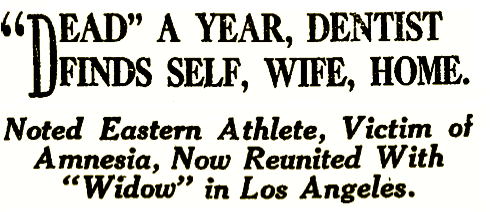 He tracks her down through her family and shows up on the Palace doorstep, and she has to give back $10,000 ($122,730 USD2007) to Bankers Life Insurance Company.
He tracks her down through her family and shows up on the Palace doorstep, and she has to give back $10,000 ($122,730 USD2007) to Bankers Life Insurance Company.
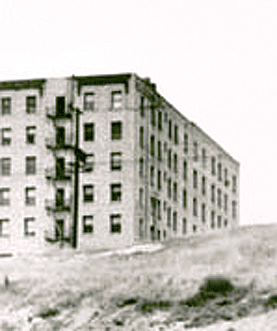
The Palace Hotel/Casa Alta was also the center of political activity for rebel rousers from Riga. Through the late 20s the papers were peppered with small notices about, for example, the precise method of sending packages to Latvia, and if you had further questions, contact the Latvian Consulate–317 S. Olive.
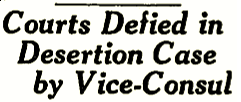 Now, Ethel M. Rising had a thing or two to say about marrying into Baltic bliss. She divorced her husband, H. R. Rising, left him in the Casa Alta, and the State awarded her $50 a month from H. R. to support their two daughters. But with that dictate Mr. Rising did not comply. Ethel complained to the City Prosecutor, who hauled Rising into court, October 2, 1928. There declared Rising: “I have been appointed Vice-Consul for Latvia and your courts have no jurisdiction over me.” The court conferred with the District Attorney and Rising was, in fact, correct. One can only imagine he threw back his head and added a hearty Latvian bwa-ha-ha-ha!
Now, Ethel M. Rising had a thing or two to say about marrying into Baltic bliss. She divorced her husband, H. R. Rising, left him in the Casa Alta, and the State awarded her $50 a month from H. R. to support their two daughters. But with that dictate Mr. Rising did not comply. Ethel complained to the City Prosecutor, who hauled Rising into court, October 2, 1928. There declared Rising: “I have been appointed Vice-Consul for Latvia and your courts have no jurisdiction over me.” The court conferred with the District Attorney and Rising was, in fact, correct. One can only imagine he threw back his head and added a hearty Latvian bwa-ha-ha-ha!
![]() November 4, 1929. George McRoy, 31, was spraying the Casa Alta with insecticide–and nearly went to exterminator Elysium, but ended up at Georgia Street Receiving.
November 4, 1929. George McRoy, 31, was spraying the Casa Alta with insecticide–and nearly went to exterminator Elysium, but ended up at Georgia Street Receiving.
 “I‘ve been taking it on the chin for five years. My chin won‘t stand it any longer–” and, after penning that short note, and adding three $1 bills for his daughter in Vancouver, sixty-five year-old relief client Frank W. Blumie climbed to the top of the Casa Alta, December 1, 1935, and leapt to his death.
“I‘ve been taking it on the chin for five years. My chin won‘t stand it any longer–” and, after penning that short note, and adding three $1 bills for his daughter in Vancouver, sixty-five year-old relief client Frank W. Blumie climbed to the top of the Casa Alta, December 1, 1935, and leapt to his death.
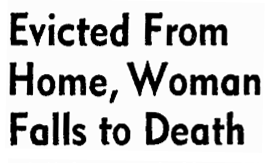 Christmas cards to Mrs. Cecilia MacKinnon Moore are being marked returned to sender this holiday season. After being told by the Casa Alta landlord to vacate her quarters, she made her way on December 23, 1947 to the famous intersection of Hollywood and Vine and to the top of the Equitable Building, from where she made her own impression on Hollywood.
Christmas cards to Mrs. Cecilia MacKinnon Moore are being marked returned to sender this holiday season. After being told by the Casa Alta landlord to vacate her quarters, she made her way on December 23, 1947 to the famous intersection of Hollywood and Vine and to the top of the Equitable Building, from where she made her own impression on Hollywood.
Two items were found in her pocketbook–a letter asking that her nephew be notified, and her eviction notice.
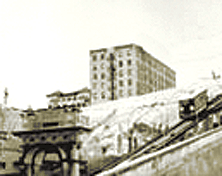
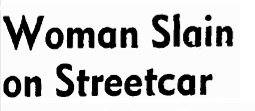 What was the relationship between Mrs. Beatrice Imogene Thompson, 23, and Sylvester Black, 34?
What was the relationship between Mrs. Beatrice Imogene Thompson, 23, and Sylvester Black, 34?
We may never know. All we know is that she was recently reconciled with her estranged husband, Willid Thompson. After two years she had returned to him, and for the past two weeks she and he were in domestic bliss at 317 S. Olive. That was, until, April 16, 1948.
Beatrice and Black knew each other from their place of employ, she a waitress, he a cook, at a downtown restaurant.
 The pair boarded an LA Transit Lines car at 11th and Broadway, and for a while argued in low tones. She was against the window, sobbing, and muttering “Leave me alone, please leave me alone.” When she rose to leave at 4th and Broadway, Black pushed her back in the seat and shot her four times. Also on the car was James F. Patrick, Special Officer, Metro Division, who pulled his piece and handcuffed Black at gunpoint, during which Black pleaded “Shoot me, please shoot me.”
The pair boarded an LA Transit Lines car at 11th and Broadway, and for a while argued in low tones. She was against the window, sobbing, and muttering “Leave me alone, please leave me alone.” When she rose to leave at 4th and Broadway, Black pushed her back in the seat and shot her four times. Also on the car was James F. Patrick, Special Officer, Metro Division, who pulled his piece and handcuffed Black at gunpoint, during which Black pleaded “Shoot me, please shoot me.”
The Thompson killing by Black, who was black, gets surprisingly little press. Perhaps the concept that this interracial killing was presaged by an interracial love affair meant that propriety demanded ignorance.
 As mentioned above, the Kellogg/Palace/Casa Alta had its relationship with the Central/Clayton/Lorraine via the mother/daughter team in the 1916 Percy Tugwell trial. The two hotels also have cranky boilers. The Central tried to blow itself up in November 1953; the year before, in November 1952, the Casa Alta boiler felt the hands of Frank Dauterman, 43, tinkering within its works. So the boiler blew itself up, failing to kill Dauterman or take down the Alta, but sending Dauterman to Georgia Street with second and third degree burns to his head, chest and arms.
As mentioned above, the Kellogg/Palace/Casa Alta had its relationship with the Central/Clayton/Lorraine via the mother/daughter team in the 1916 Percy Tugwell trial. The two hotels also have cranky boilers. The Central tried to blow itself up in November 1953; the year before, in November 1952, the Casa Alta boiler felt the hands of Frank Dauterman, 43, tinkering within its works. So the boiler blew itself up, failing to kill Dauterman or take down the Alta, but sending Dauterman to Georgia Street with second and third degree burns to his head, chest and arms.

A month later, December 20, 1952, residents heard screams from the apartment of Willie Kohl, 79. His apartment was aflame; he was found on the floor near the bed, and died en route to Georgia Street.
Kohl’s conflagration is the Casa Alta’s final appearance in the Times. The remaining tenants are relocated in the late 60s and it soon becomes a tall pile of brick.
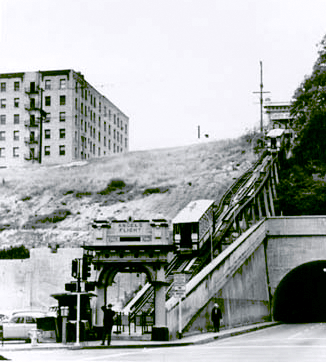
And atop the old site, the 1990 Omni Hotel, in which one can sense a vague hint of the old Alta. Vaguely.
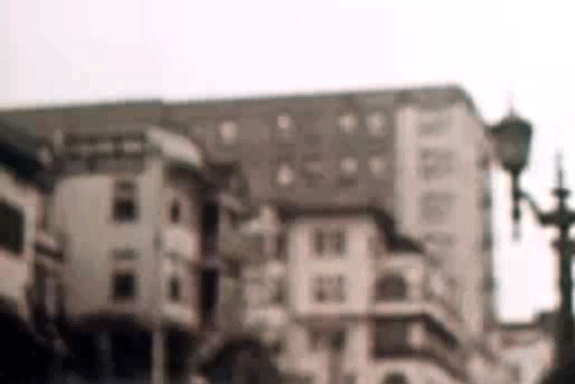
Washington hatchet from here; bloody hatchet from Hatchet; Palace postcard, author; 1910 Ems, Los Angeles Public Library; 1960 Ems, Metropolitan Museum of Art; view up Olive, USC Libraries Digital Archives; census card, USC Libraries Digital Archives; Casa Alta with Angels Flight, Los Angeles Public Library. Bottom image you remember from Subject: Narcotics.

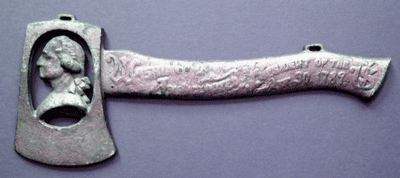
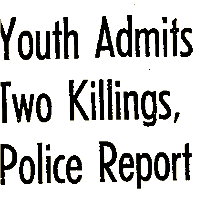
 1947project readers may remember
1947project readers may remember 

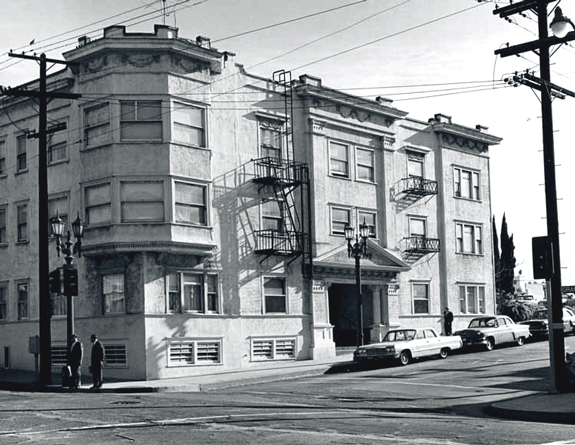
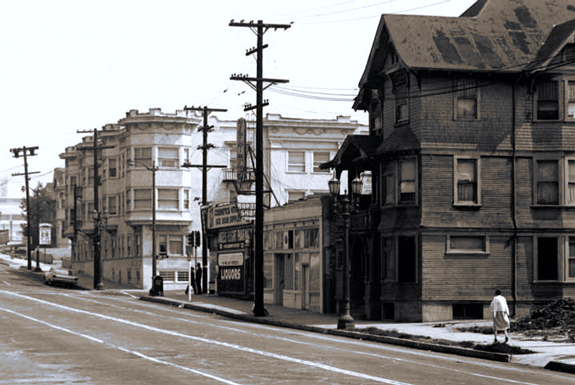
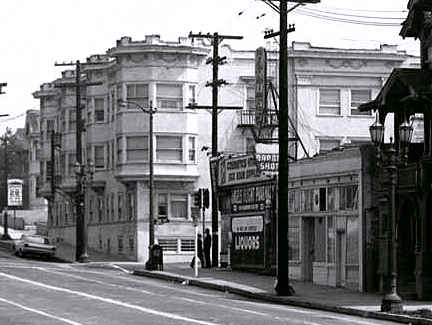
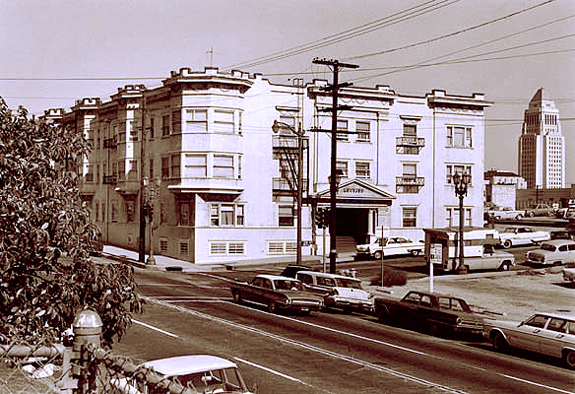

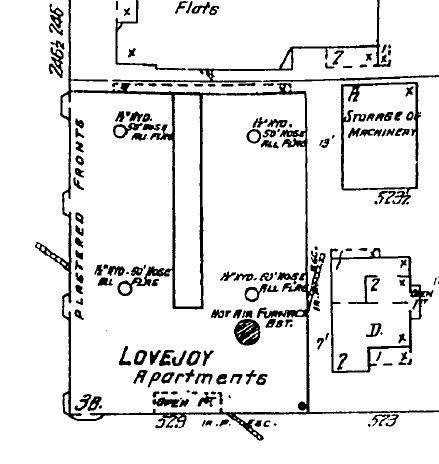
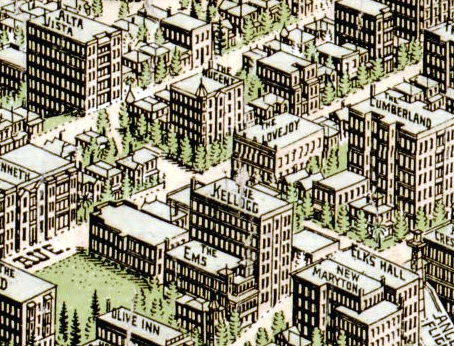

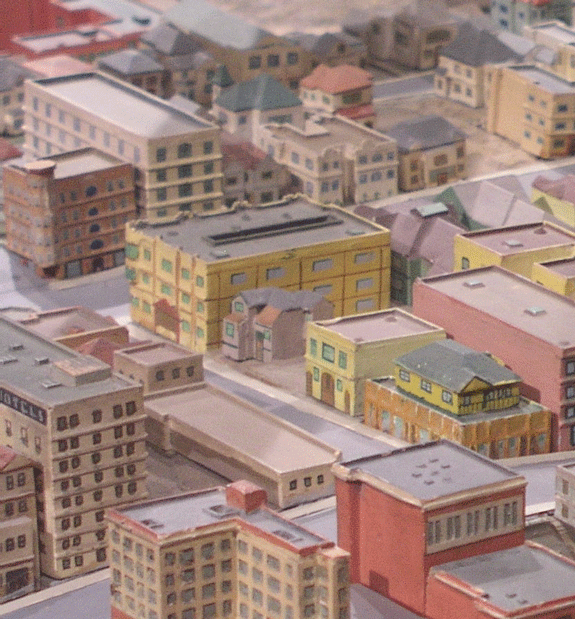
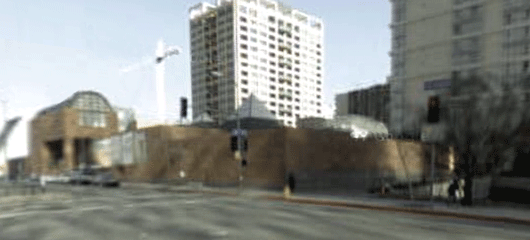
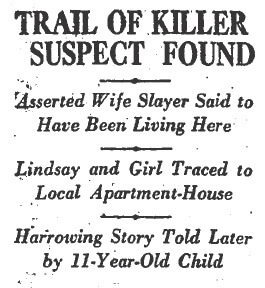

 Grabbing his 12 year old foster daughter Pearl Grant, and a few hastily packed bags, Frank fled his home and high-tailed it south.
Grabbing his 12 year old foster daughter Pearl Grant, and a few hastily packed bags, Frank fled his home and high-tailed it south.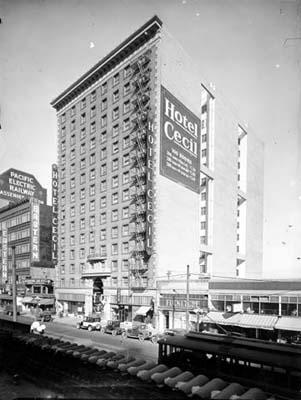
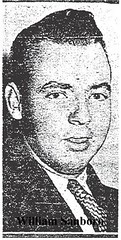 For a few of the months he was on the run, Frank had worked as a fry cook in the restaurant that Sanborn managed on
For a few of the months he was on the run, Frank had worked as a fry cook in the restaurant that Sanborn managed on 
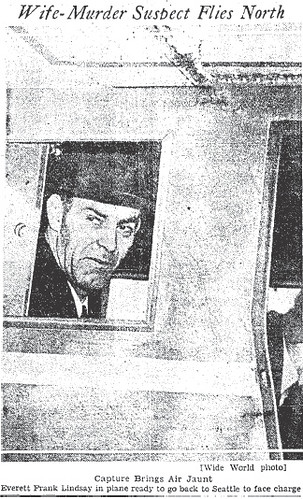
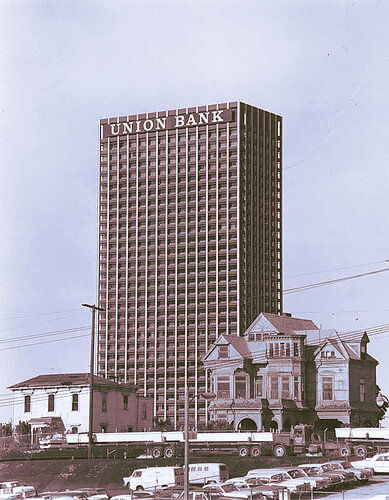
 As has been
As has been 
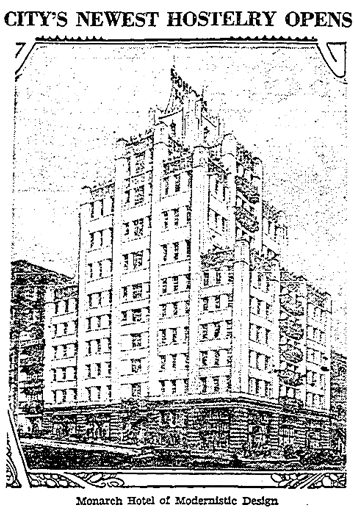

 Night clerk H. N. Willey was behind the desk at the Monarch when, just after midnight on June 16, 1930, a bandit robbed him of $26. Willey phoned Central Station. Meanwhile, officers Doyle and Williams, on patrol, observed a man hightailing it through an auto park near the hotel. Deciding that he wasn‘t running for his health (this being some years before the jogging craze), they gave chase and caught him in an alley. They next observed a patrol car flying to the Monarch. Putting two and two together, they took their prisoner to the hotel, where he was id‘d by Willey. Turns out he was George H. Hall, 24, a recent arrival in Los Angeles.
Night clerk H. N. Willey was behind the desk at the Monarch when, just after midnight on June 16, 1930, a bandit robbed him of $26. Willey phoned Central Station. Meanwhile, officers Doyle and Williams, on patrol, observed a man hightailing it through an auto park near the hotel. Deciding that he wasn‘t running for his health (this being some years before the jogging craze), they gave chase and caught him in an alley. They next observed a patrol car flying to the Monarch. Putting two and two together, they took their prisoner to the hotel, where he was id‘d by Willey. Turns out he was George H. Hall, 24, a recent arrival in Los Angeles. 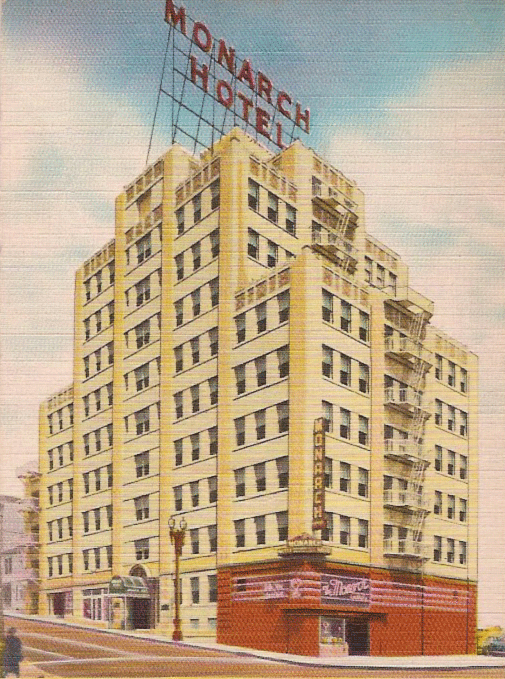
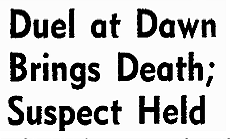
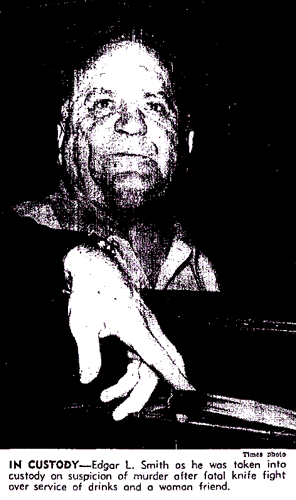
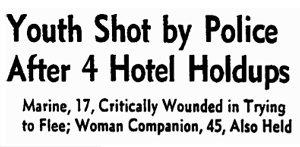
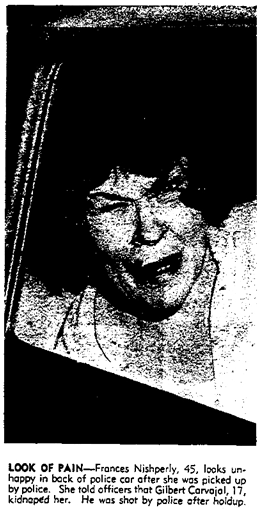
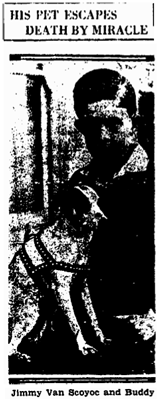
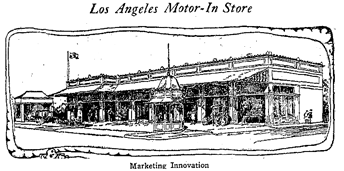 Lead architects on the Monarch are Cramer & Wise, who did pioneering auto-culture work with their 1926 “Motor-In Markets”–one at the
Lead architects on the Monarch are Cramer & Wise, who did pioneering auto-culture work with their 1926 “Motor-In Markets”–one at the 
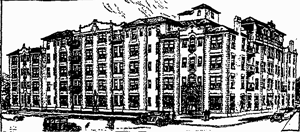 …of course, what they‘re best known for is
…of course, what they‘re best known for is  While Mediterranean in manner, their 1929
While Mediterranean in manner, their 1929 

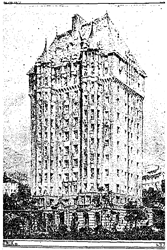
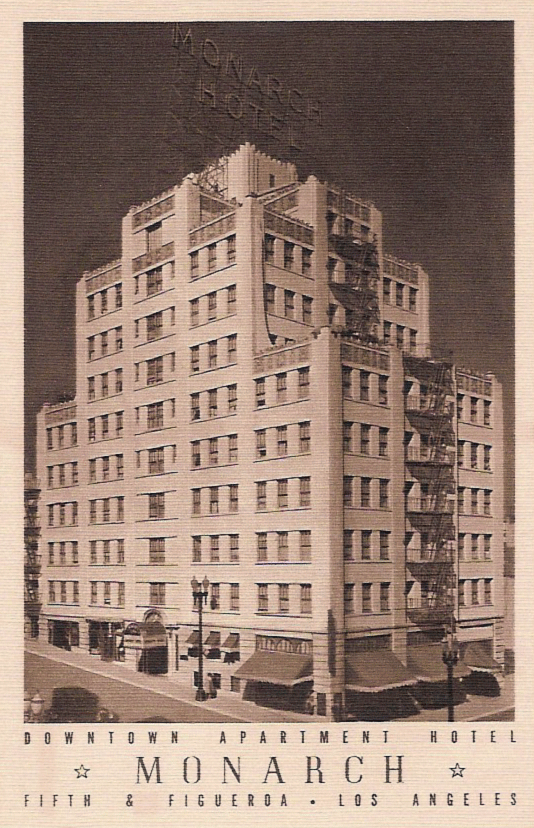
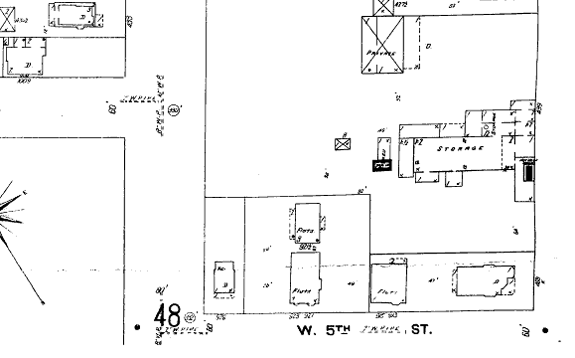
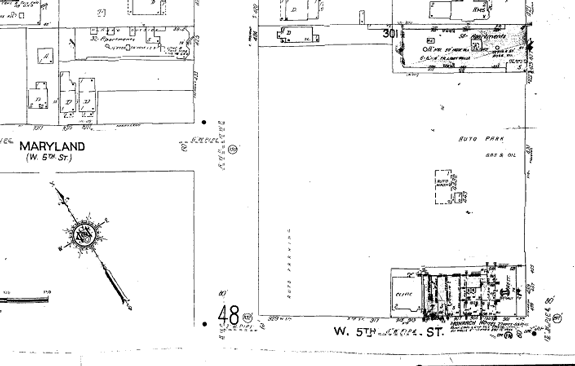
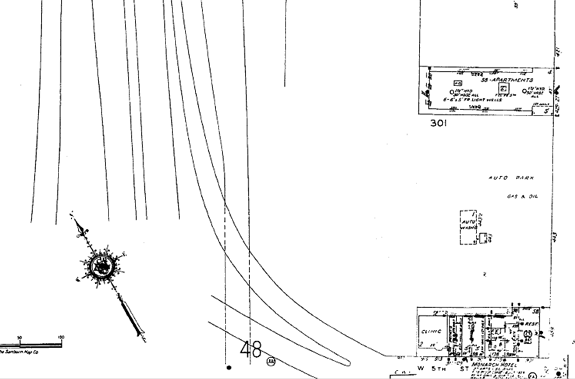

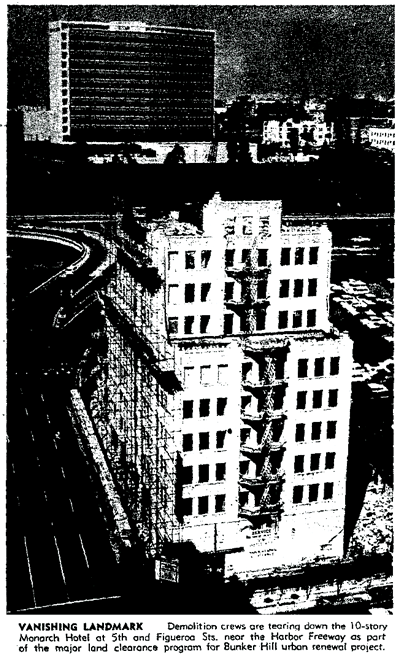
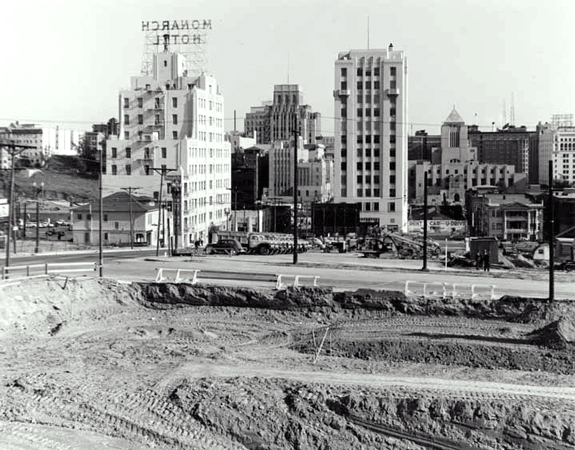
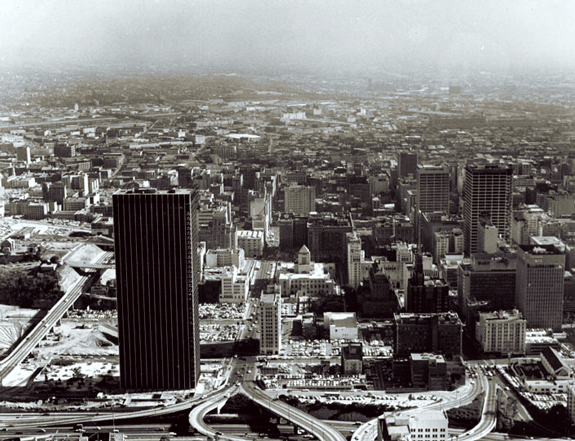
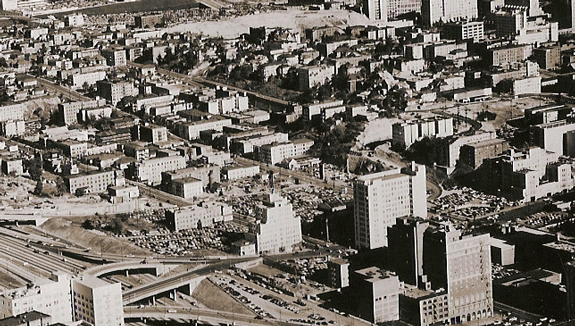

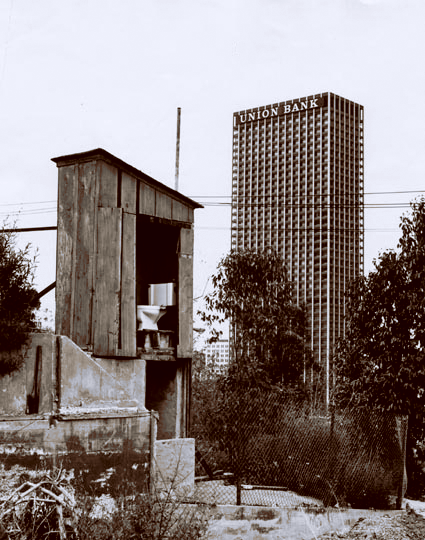

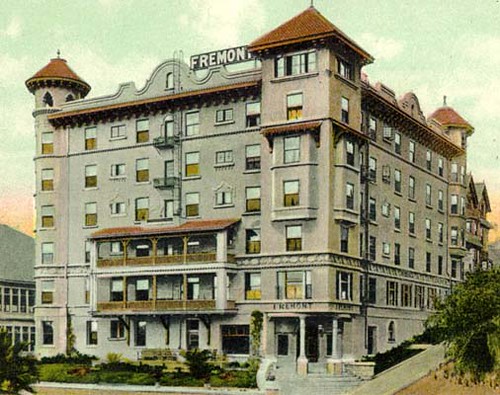
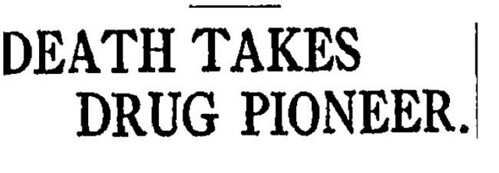
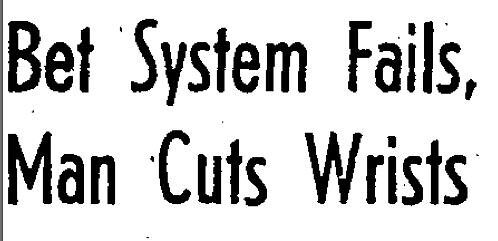

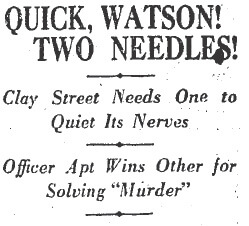


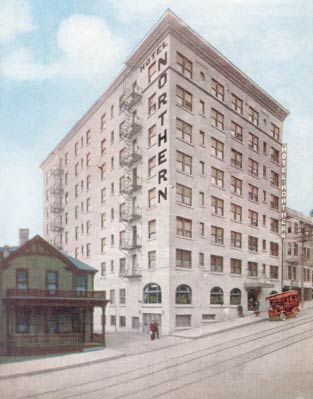


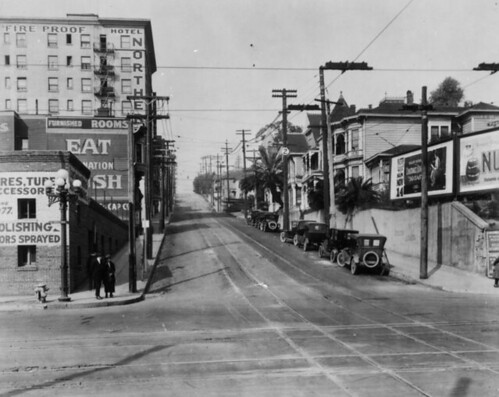
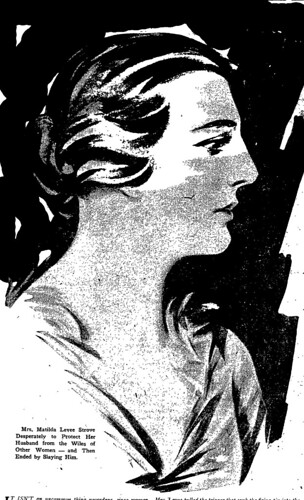


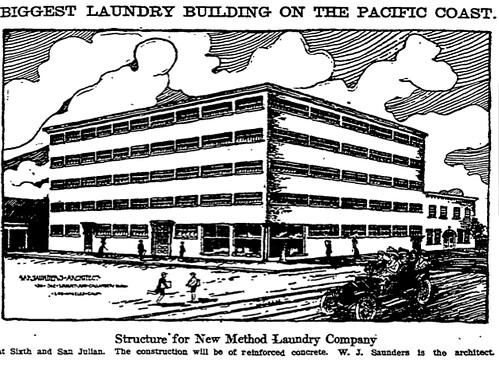
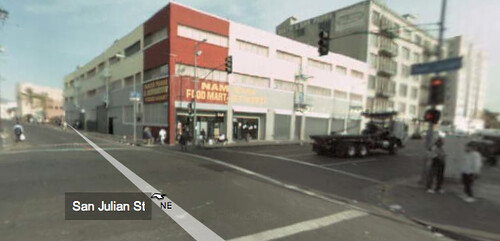
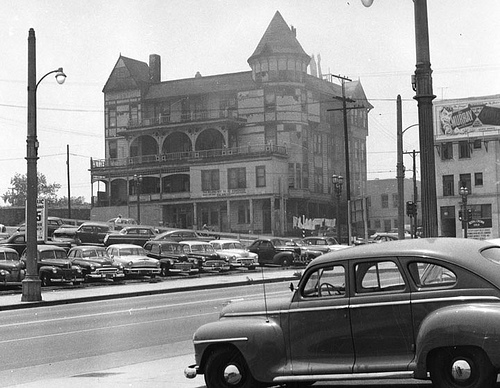
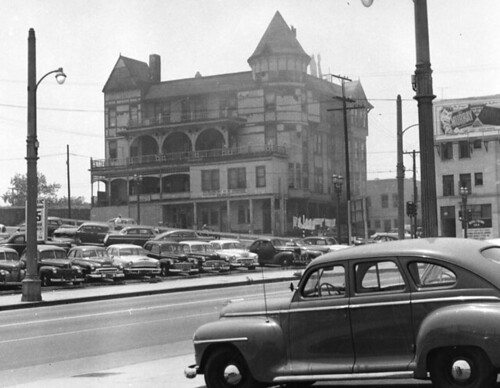
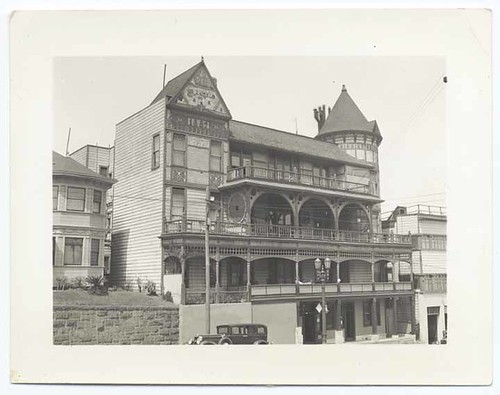
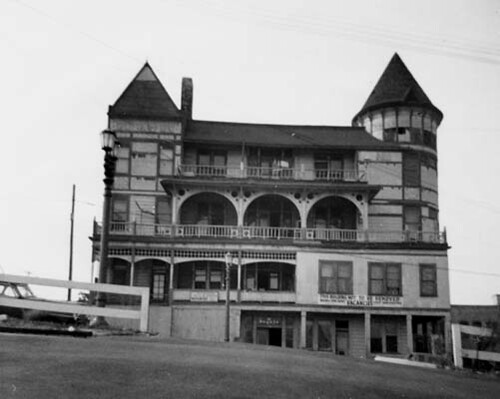

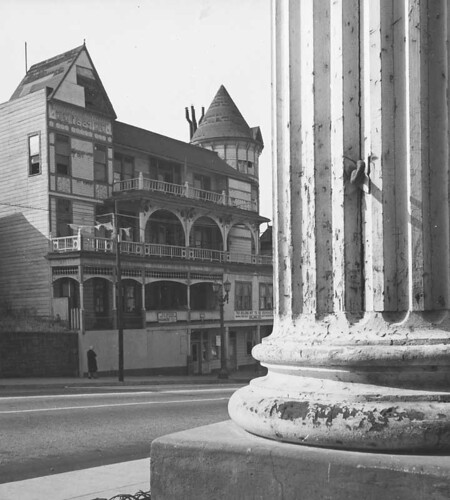

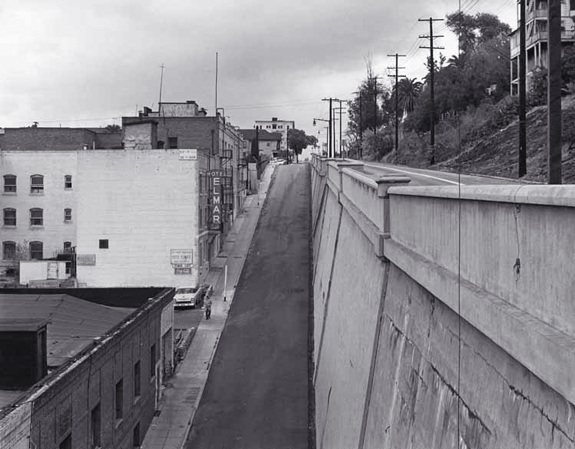

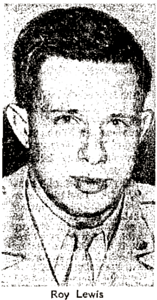 February 21, 1947. Our first resident of the Elmar, Ex-Cpl. Roy (Peewee) Lewis, 23, formerly of Joliet, Ill, is one of those war vets who came to Los Angeles. Los Angeles, the promise of the good life. You could become anyone. Your face could be up on the big screen! Plastered on billboards! Peewee at least got his plastered all over the corner of
February 21, 1947. Our first resident of the Elmar, Ex-Cpl. Roy (Peewee) Lewis, 23, formerly of Joliet, Ill, is one of those war vets who came to Los Angeles. Los Angeles, the promise of the good life. You could become anyone. Your face could be up on the big screen! Plastered on billboards! Peewee at least got his plastered all over the corner of 
 March 21, 1952. Martin Salas, 23, left the Elmar‘s confines for an early morning
March 21, 1952. Martin Salas, 23, left the Elmar‘s confines for an early morning 

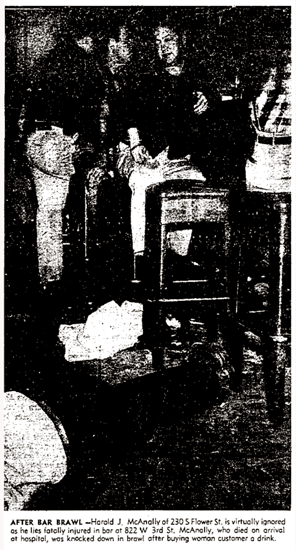
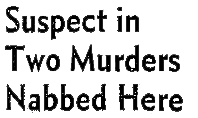
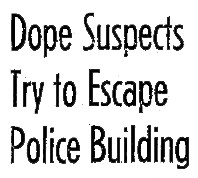
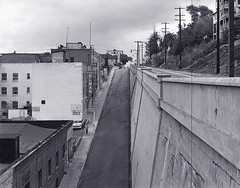 Kind of makes you want to check into 235 South Hope, doesn’t it? Perhaps you too can soak up enough of its magic to place you on this honored roll.
Kind of makes you want to check into 235 South Hope, doesn’t it? Perhaps you too can soak up enough of its magic to place you on this honored roll.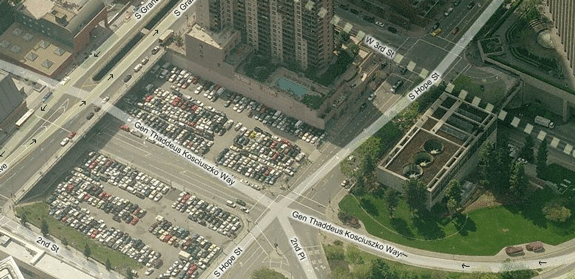 Today, the bilevel nature of Hope Street is five decades gone. The Ghost Elmar floats roughly above an intersection made by a new street, named after a Lithuanian-Ruthenian
Today, the bilevel nature of Hope Street is five decades gone. The Ghost Elmar floats roughly above an intersection made by a new street, named after a Lithuanian-Ruthenian 
